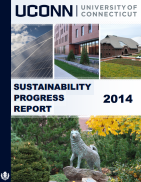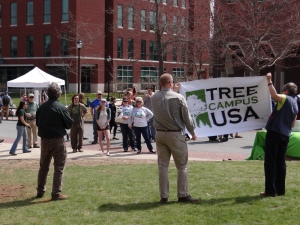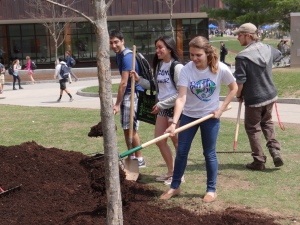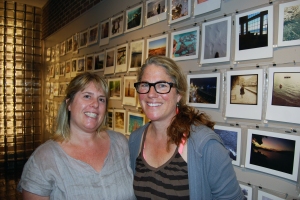Another fantastic semester has come to a close! Several key events took place this fall, and many more are underway for the coming year. Below is a brief summary of the activities that the Office of Environmental Policy hosted and participated in, encouraging sustainability and environmental awareness.
Green Game Day
On September 7th, almost 50 volunteers gathered to promote recycling at the Green Game Day for UConn Football versus Stony Brook. Everyone who came to the game enjoyed seeing a closely contested 19-16 UConn victory. The volunteers teamed up in groups to pick up recyclables at each of the tailgating lots. This allowed for an interactive learning opportunity for the wider community regarding everything that UConn does to be more environmentally conscience. For more information, click here.
Climate March
 On Sunday, September 21st, over 80 UConn students participated along with 400,000 others in the People’s Climate March (PCM) in New York City. The march was organized, leading up to the UN Climate Summit on September 23rd, to raise awareness about and form a united front against climate change. UConn’s participation in the march was a reflection on both the university’s goals to protect our local environmental and our planet. To see more pictures and read one of our interns’ perspective on joining the march, please click here.
On Sunday, September 21st, over 80 UConn students participated along with 400,000 others in the People’s Climate March (PCM) in New York City. The march was organized, leading up to the UN Climate Summit on September 23rd, to raise awareness about and form a united front against climate change. UConn’s participation in the march was a reflection on both the university’s goals to protect our local environmental and our planet. To see more pictures and read one of our interns’ perspective on joining the march, please click here.
EcoMadness
 Two all-time EcoMadness records, the most volunteer Eco-Captains we’ve had in the past five years, and a lot of UConn Dairy Bar ice cream highlighted this year’s EcoMadness Competition. The winners cut down water usage to an incredible 17.9 gallons of water used per student (Grange/Hicks), reduced water consumption by 20% per capita (Troy/Shakespeare), and conserved energy by 23% (Buckley). These impressive reductions were made possible by increased collaboration with residence assistants and student leadership through Eco-Captains. If you would like to learn more about this year’s competition click here!
Two all-time EcoMadness records, the most volunteer Eco-Captains we’ve had in the past five years, and a lot of UConn Dairy Bar ice cream highlighted this year’s EcoMadness Competition. The winners cut down water usage to an incredible 17.9 gallons of water used per student (Grange/Hicks), reduced water consumption by 20% per capita (Troy/Shakespeare), and conserved energy by 23% (Buckley). These impressive reductions were made possible by increased collaboration with residence assistants and student leadership through Eco-Captains. If you would like to learn more about this year’s competition click here!
Sustainability Report

This fall also saw the release of UConn’s very first sustainability report. Through a collaborative effort, the report highlights both the university’s environmental outreach efforts as well as a wide range of sustainability metrics from the Sustainability Tracking, Assessment & Rating System (STARS) survey. Click here to access the 2014 Sustainability Report.












 Volunteers wearing blue and green EcoHusky and EcoHouse T-shirts teamed up in groups to pick up recyclables at each of the tailgating lots (Red, blue, grey). Tailgaters were very appreciative of the efforts and were open to discussing UConn sustainability initiatives. Overall, the event was very successful – volunteers filled the dumpsters with recyclables and fans were eager to participate!
Volunteers wearing blue and green EcoHusky and EcoHouse T-shirts teamed up in groups to pick up recyclables at each of the tailgating lots (Red, blue, grey). Tailgaters were very appreciative of the efforts and were open to discussing UConn sustainability initiatives. Overall, the event was very successful – volunteers filled the dumpsters with recyclables and fans were eager to participate!




